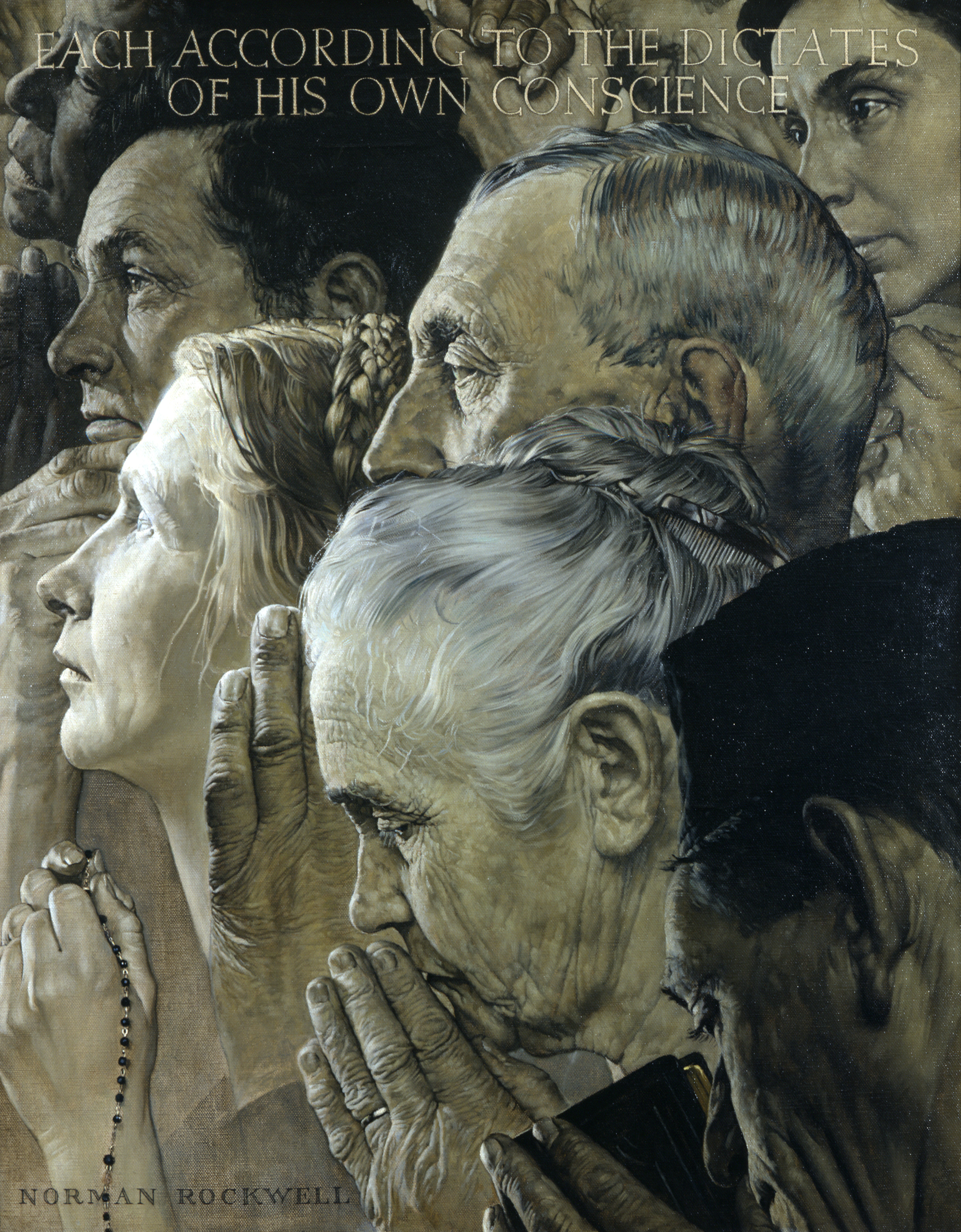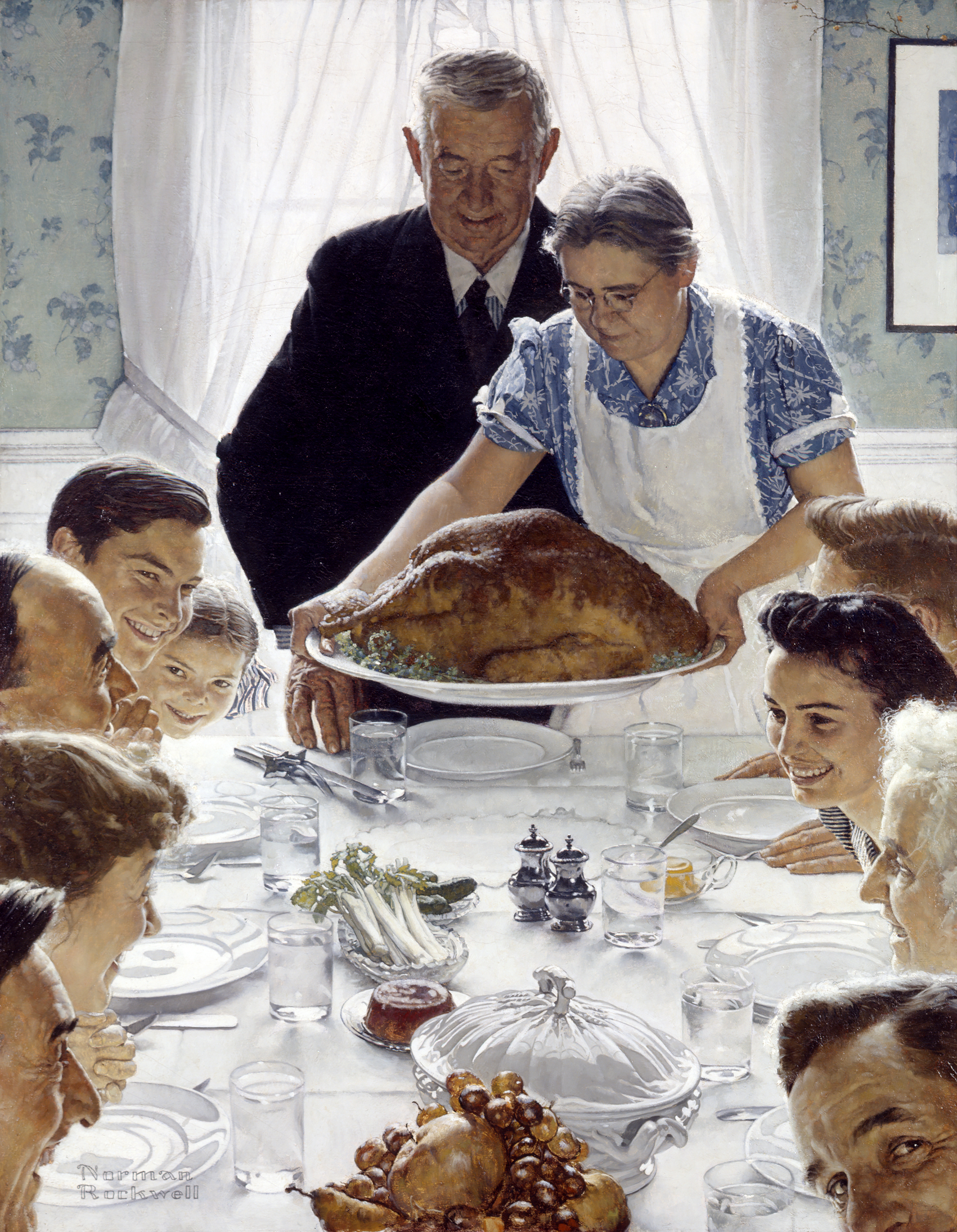Close Reading of the Four Freedom Illustrations
Overview:
Students will be introduced to the Four Freedoms which President Roosevelt identified in his 1941 State of the Union Address to Congress. Each of these freedoms, including Freedom of Speech, Freedom of Worship, Freedom from Want, and Freedom from Fear will be addressed individually. Through close reading of the illustrations by Norman Rockwell, students will identify details contained in the paintings. They will use these details to make and support inferences reflecting the meaning of the Four Freedoms in our everyday lives.
Enduring Understandings / Essential Questions:
- The Four Freedoms are for all people.
- President Roosevelt named the Four Freedoms as Freedom of Speech, Freedom of Worship, Freedom from Want, and Freedom from Fear.
- While the Four Freedoms are reflected in many of our lives, there are still people in the world who do not have these freedoms.
- What does “freedom” mean to you?
- How are the Four Freedoms reflected in your life?
- Does everyone in the world have these freedoms?
- Are there other “freedoms” everyone should have?
- Grade
- K-2
- Theme
- Four Freedoms
- Length
- The lesson for each illustration should be 20 to 30 minutes and taught over four different days.
- Discipline
- Social Studies, Language Arts: Reading, Language Arts: Speaking and Listening
- Vocabulary
- Freedom; Speech; Worship; Want; Fear; Cooperation; Need; Fairness; Equal rights
Objectives:
- Students will closely examine each of the Four Freedom illustrations painted by Norman Rockwell.
- Students will make inferences related to the details of each specific freedom.
- Students will reflect on the how the Four Freedoms relate to them.
- Students will participate in discussions focusing on the Four Freedoms.
Background:
World War II began in 1939. The United States was not involved in the beginning of the war, however, President Franklin Roosevelt believed that the United States would eventually need to play a larger role. In January 1941, he made his speech to Congress. In his speech, President Roosevelt named the Four Freedoms, which he stated are the rights of everyone in the world. After the speech, in an effort to convey the underlying message of the Four Freedoms, the President reached out to the art world for help. Many artists created works to reflect the meaning of these freedoms in the form of paintings, sculptures, prints, musical compositions, and more. Norman Rockwell thought a lot about these ideals. In February and March of 1943, his completed Four Freedoms illustrations were published in The Saturday Evening Post, each along with a related essay. Exceedingly popular at the time and distributed widely as prints and posters, Norman Rockwell's illustrations raised over 132 million dollars toward the war effort through the purchase of war bonds. Prints of Rockwell’s Four Freedoms were given as premiums when people purchased war bonds in varying denominations. His illustrations became the face of the Four Freedoms and they continue to represent the meaning of these freedoms today.
Note: In Primary grades, when sharing information about the war, focus on the desire of people to create a world in which all people have equal rights. Emphasis on fairness, working together for a common cause, and the essence of the Four Freedoms drives the discussion.
Materials:
Multimedia Resources
"Freedom of Speech"
"Freedom of Worship
"Freedom from Fear"
"Freedom from Want"
Norman Rockwell's Four Freedoms
Norman Rockwell Museum
Franklin D. Roosevelt's Four Freedoms
Norman Rockwell Museum
Classroom Supplies:
- Large Pad or White Board with T-chart labeled “What I see (noticed) / What I think (can infer)
- Marker
Worksheets:
Activities:
Present each illustration separately. Allow 20 to 30 minutes for the reading and discussion of each. Consider sharing the Four Freedoms in the order in which President Roosevelt presented them - the same procedure can be utilized for each image.
- Display the illustration of Freedom of Speech.
- Ask students to look carefully at the illustration. Give them a few minutes to do this.
- Turn and Talk: When you feel enough time has passed, have students turn to a person sitting beside them. Ask them to share with each other some of the things they notice in the illustration. As they are sharing, move around the room and check in on their conversations.
- Have partners share some of the things they noticed in the picture. Record their responses on chart paper. Bring forward points heard during conversations that have not been shared.
- Turn and Talk: When everyone has had the opportunity to share, ask students to face their partners again. Tell them to discuss with their partner what events might be called to mind by the painting, such as speaking out in class or listening respectfully.
- Have partners share their thinking and record responses on the T-chart. Underscore those responses by referencing specific details in the painting.
- New observations may be contributed as students look more closely at the details. Add them to the appropriate column on the T-Chart.
- Share the origin of the painting and its name. Give as much information as is appropriate for the maturity of the students. At some point, you may want to discuss the use of the word “speech” in the title of Freedom of Speech, or progressively, “worship,” “want,” and “fear.” For example, many students may associate the word “want” with things they wish to have rather than “want of necessities,” such as food, shelter, water, companionship, and other basic needs. Point out to students that there are four paintings in this group of works by Norman Rockwell. They will have the opportunity to view and discuss the other paintings later.
- Have students reflect on how the freedom illustrated in the painting is reflected in their lives. Are there other freedoms, beyond these four, that might be important? What are they?
Before sharing another illustration, you may want to choose a follow-up activity associated with this image from the K-2 menu of activities.
Assessment:
- Did all students participate?
- Were students able to give details from the picture to support their thinking?
- Were students able to identify ways in which the Four Freedoms are evident in their lives?
- Have students identified individuals or groups who may not have these freedoms?
- Can they suggest solutions that could help bring the Four Freedoms to others in some way?
- Did the students build on the ideas of other students?
- Did they share original ideas in addition to building upon the thoughts of others?
- Did students identify other freedoms which they believe are important?
Standards
This curriculum meets the standards listed below. Look for more details on these standards please visit: ELA and Math Standards, Social Studies Standards, Visual Arts Standards.
- CCSS.ELA-Literacy.SL.1.1
- Participate in collaborative conversations with diverse partners about grade 1 topics and texts with peers and adults in small and larger groups.
- CCSS.ELA-Literacy.SL.1.2
- Ask and answer questions about key details in a text read aloud or information presented orally or through other media.
- CCSS.ELA-Literacy.SL.1.3
- Ask and answer questions about what a speaker says in order to gather additional information or clarify something that is not understood.
- CCSS.ELA-Literacy.SL.1.6
- Produce complete sentences when appropriate to task and situation. (See grade 1 Language standards 1 and 3 [link to="CCSS.ELA-Literacy.L.1"]here[/link] for specific expectations.)
- CCSS.ELA-Literacy.SL.2.1
- Participate in collaborative conversations with diverse partners about grade 2 topics and texts with peers and adults in small and larger groups.
- CCSS.ELA-Literacy.SL.2.2
- Recount or describe key ideas or details from a text read aloud or information presented orally or through other media.
- CCSS.ELA-Literacy.SL.2.3
- Ask and answer questions about what a speaker says in order to clarify comprehension, gather additional information, or deepen understanding of a topic or issue.
- CCSS.ELA-Literacy.SL.2.6
- Produce complete sentences when appropriate to task and situation in order to provide requested detail or clarification. (See grade 2 Language standards 1 and 3 [link to="CCSS.ELA-Literacy.L.2"]here[/link] for specific expectations.)
- CCSS.ELA-Literacy.SL.K.1
- Participate in collaborative conversations with diverse partners about kindergarten topics and texts with peers and adults in small and larger groups.
- CCSS.ELA-Literacy.SL.K.2
- Confirm understanding of a text read aloud or information presented orally or through other media by asking and answering questions about key details and requesting clarification if something is not understood.
- CCSS.ELA-Literacy.SL.K.3
- Ask and answer questions in order to seek help, get information, or clarify something that is not understood.
- CCSS.ELA-Literacy.SL.K.6
- Speak audibly and express thoughts, feelings, and ideas clearly.
- CCSS.ELA-Literacy.RI.1.1
- Ask and answer questions about key details in a text.
- CCSS.ELA-Literacy.RI.1.7
- Use the illustrations and details in a text to describe its key ideas.
- CCSS.ELA-Literacy.RI.2.1
- Ask and answer such questions as who, what, where, when, why, and how to demonstrate understanding of key details in a text.
- CCSS.ELA-Literacy.RI.2.7
- Explain how specific images (e.g., a diagram showing how a machine works) contribute to and clarify a text.
- CCSS.ELA-Literacy.RI.K.1
- With prompting and support, ask and answer questions about key details in a text.
- CCSS.ELA-Literacy.RI.K.7
- With prompting and support, describe the relationship between illustrations and the text in which they appear (e.g., what person, place, thing, or idea in the text an illustration depicts).
- D1.1.K-2.
- Explain why the compelling question is important to the student.
- D1.2.K-2.
- Identify disciplinary ideas associated with a compelling question.
- D1.5.K-2.
- Determine the kinds of sources that will be helpful in answering compelling and supporting questions.
- D2.Civ.1.K-2.
- Describe roles and responsibilities of people in authority.
- D2.Eco.2.K-2.
- Identify the benefits and costs of making various personal decisions.
- D2.Geo.5.K-2.
- Describe how human activities affect the cultural and environmental characteristics of places and regions.
- D2.His.2.K-2.
- Compare life in the past to life today.
- D2.His.3.K-2.
- Generate questions about individuals and groups who have shaped a significant historical change.
- D4.2.K-2.
- Construct explanations using correct sequence and relevant information.
- D4.7.K-2.
- Identify ways to take action to help address local, regional, and global problems.



